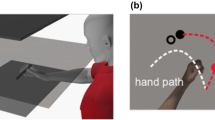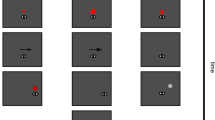Abstract
A prediction-based error signal, neurally computed as the difference between predicted and observed movement outcomes, has been proposed as the driving force for motor learning. This suggests that the generation of predictive saccades to periodically paced targets—whose performance accuracy is actively maintained using this same error signal—invokes the motor-learning network. We examined whether a simple predictive-saccade task (implicit double-step adaptation, in which targets are gradually displaced outward to exaggerate normal hypometric movement errors) can stand in place of a traditional double-step saccade-adaptation task to induce an increase in saccade gain. We find that the implicit double-step adaptation task can induce significant gain-increase adaptation (of comparable magnitude to that of the standard double-step task) in normal control subjects. Unlike control subjects, patients with impaired cerebella are unable to adapt their saccades in response to this paradigm; this implies that the cerebellum is crucial for processing prediction-based error signals for motor learning.



Similar content being viewed by others
References
Alahyane N, Pelisson D (2005) Long-lasting modifications of saccadic eye movements following adaptation induced in the double-step target paradigm. Learn Mem 12:433–443
Bahcall DO, Kowler E (2000) The control of saccadic adaptation: implications for the scanning of natural visual scenes. Vis Res 40:2779–2796
Bastian AJ (2006) Learning to predict the future: the cerebellum adapts feedforward movement control. Curr Opin Neurobiol 16:645–649
Bronstein AM, Kennard C (1987) Predictive eye saccades are different from visually triggered saccades. Vis Res 27:517–520
Collins T, Wallman J (2012) The relative importance of retinal error and prediction in saccadic adaptation. J Neurophysiol 107:3342–3348
Criscimagna-Hemminger SE, Bastian AJ, Shadmehr R (2010) Size of error affects cerebellar contributions to motor learning. J Neurophysiol 103:2275–2284
Ethier V, Zee DS, Shadmehr R (2008) Spontaneous recovery of motor memory during saccade adaptation. J Neurophysiol 99:2577–2583
Fujita M, Amagai A, Minakawa F, Aoki M (2002) Selective and delay adaptation of human saccades. Cogn Brain Res 13:41–52
Golla H, Tziridis K, Haarmeier T, Catz N, Barash S, Thier P (2008) Reduced saccadic resilience and impaired saccadic adaptation due to cerebellar disease. Eur J Neurosci 27:132–144
Henson DB (1978) Corrective saccades: effects of altering visual feedback. Vis Res 18:63–67
Honjo K, Ohshita T, Kawakami H et al (2004) Quantitative assessment of cerebral blood flow in genetically confirmed spinocerebellar ataxia type 6. Arch Neurol 61:933–937
Ikegami T, Hirashima M, Taga G, Nozaki D (2010) Asymmetric transfer of visuomotor learning between discrete and rhythmic movements. J Neurosci 30:4515–4521
Ishikawa K, Watanabe M, Yoshizawa K et al (1999) Clinical, neuropathological, and molecular study in two families with spinocerebellar ataxia type 6 (SCA6). J Neurol Neurosurg Psychiatr 67:86–89
Isotalo E, Lasker AG, Zee DS (2005) Cognitive influences on predictive saccadic tracking. Exp Brain Res 165:461–469
Izawa J, Criscimagna-Hemminger SE, Shadmehr R (2012) Cerebellar contributions to reach adaptation and learning sensory consequences of action. J Neurosci 32:4230–4239
Joiner WM, Shelhamer M, Ying SH (2005) Cerebellar influence in oculomotor phase-transition behavior. Ann N Y Acad Sci 1039:536–539
Lasker AG, Isotalo EH, Zee DS (2005) Predictive saccades to a regularly alternating target in cerebellar patients. Ann N Y Acad Sci 1039:544–547
Leigh RJ, Zee DS (2006) The neurology of eye movements. Oxford University Press, New York
Mazzoni P, Krakauer JW (2006) An implicit plan overrides an explicit strategy during visuomotor adaptation. J Neurosci 26:3642–3645
Mclaughlin SC (1967) Parametric adjustment in saccadic eye movements. Percept Psychophys 2:359–362
Mehta B, Schaal S (2002) Forward models in visuomotor control. J Neurophysiol 88:942–953
Melis BJ, van Gisbergen JA (1996) Short-term adaptation of electrically induced saccades in monkey superior colliculus. J Neurophysiol 76:1744–1758
Miall RC (1998) The cerebellum, predictive control and motor coordination. Novartis Found Symp 218:272–284; discussion 284–290
Miall RC, Wolpert DM (1996) Forward models for physiological motor control. Neural Netw 9:1265–1279
Miller JM, Anstis T, Templeton WB (1981) Saccadic plasticity: parametric adaptive control by retinal feedback. J Exp Psychol Hum Percept Perform 7:356–366
Morton SM, Bastian AJ (2006) Cerebellar contributions to locomotor adaptations during splitbelt treadmill walking. J Neurosci 26:9107–9116
Nagel M, Behrmann H, Zangemeister WH (2008) Disturbance of predictive response initiation of eye and head movements in cerebellar patients. Eur Neurol 60:179–185
Robinson DA (1963) A method of measuring eye movement using a scleral search coil in a magnetic field. IEEE Trans Biomed Eng 10:137–145
Sasaki H, Kojima H, Yabe I et al (1998) Neuropathological and molecular studies of spinocerebellar ataxia type 6 (SCA6). Acta Neuropathol 95:199–204
Shelhamer M (2005) Sequences of predictive saccades are correlated over a span of approximately 2 s and produce a fractal time series. J Neurophysiol 93:2002–2011
Shelhamer M, Joiner WM (2003) Saccades exhibit abrupt transition between reactive and predictive; predictive saccade sequences have long-term correlations. J Neurophysiol 90:2763–2769
Stark L, Young LR, Vossius G (1962) Predictive control of eye tracking movements. Ire Trans Hum Factors Electron Hfe 3:52–57
Straube A, Deubel H, Ditterich J, Eggert T (2001) Cerebellar lesions impair rapid saccade amplitude adaptation. Neurology 57:2105–2108
Trouillas P, Takayanagi T, Hallett M et al (1997) International cooperative ataxia rating scale for pharmacological assessment of the cerebellar syndrome. The Ataxia Neuropharmacology Committee of the World Federation of Neurology. J Neurol Sci 145:205–211
Tseng YW, Diedrichsen J, Krakauer JW, Shadmehr R, Bastian AJ (2007) Sensory prediction errors drive cerebellum-dependent adaptation of reaching. J Neurophysiol 98:54–62
Wolpert DM, Miall RC, Kawato M (1998) Internal models in the cerebellum. Trends Cogn Sci 2:338–347
Wong AL, Shelhamer M (2011a) Exploring the fundamental dynamics of error-based motor learning using a stationary predictive-saccade task. PLoS One 6:e25225
Wong AL, Shelhamer M (2011b) Saccade adaptation improves in response to a gradually introduced stimulus perturbation. Neurosci Lett 500:207–211
Wong AL, Shelhamer M (2011c) Sensorimotor adaptation error signals are derived from realistic predictions of movement outcomes. J Neurophysiol 105:1130–1140
Xu-Wilson M, Chen-Harris H, Zee DS, Shadmehr R (2009) Cerebellar contributions to adaptive control of saccades in humans. J Neurosci 29:12930–12939
Acknowledgments
We gratefully acknowledge DC Roberts for technical assistance. We also thank SH Ying, AX Du, BC Jung, E Bryant-Cavazos, and E Murray for their assistance in recruiting SCA6 patients and conducting ICARS tests. This work was supported by NSF grant BCS-1126957, NIH grant R21-EY019713, and NIH grant T32 DC000023.
Author information
Authors and Affiliations
Corresponding author
Rights and permissions
About this article
Cite this article
Wong, A.L., Shelhamer, M. Using prediction errors to drive saccade adaptation: the implicit double-step task. Exp Brain Res 222, 55–64 (2012). https://doi.org/10.1007/s00221-012-3195-4
Received:
Accepted:
Published:
Issue Date:
DOI: https://doi.org/10.1007/s00221-012-3195-4




